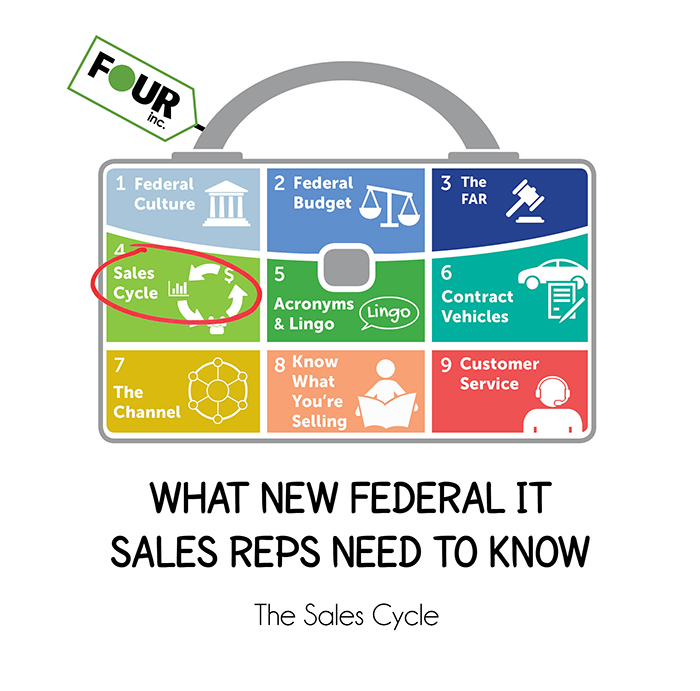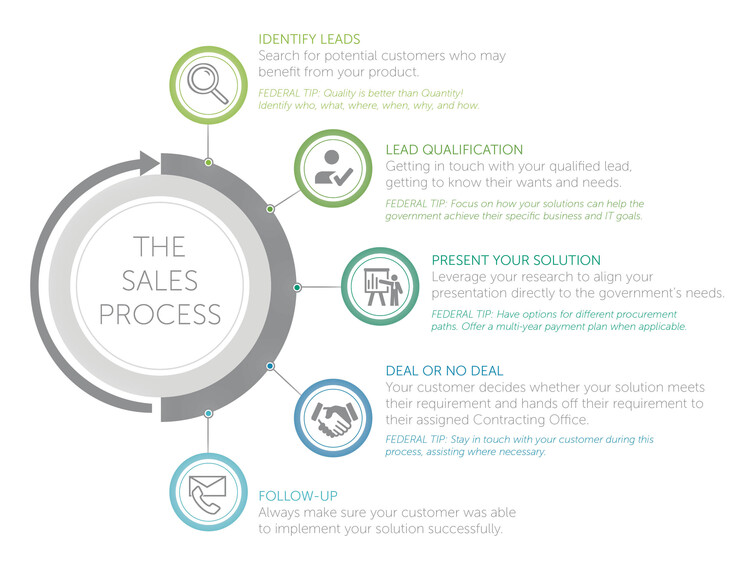News
Making IT happen
What New Federal IT Sales Reps Need to Know: The Sales Cycle - Federalized

Thanks for joining us for another edition of What New Federal IT Sales Reps Need to Know! In this blog we focus on the Federal Sales Process and some best-practices to strive for as you’re doing business with the Federal Government. Below, we discuss a typical sales process and provide some tips to help you become a Federal Sales Cycle Connoisseur.
Let’s start with the basics! A sales process is a set of repeatable steps that a sales representative executes, from identifying leads through a closed sale.
Below we have outlined a typical sales process, broken up into five phases.
Quick note: each sales process will be unique based on your product, customer, and several other variables. We’ve described a typical cycle below.
To make it easy for those of you who are new to federal IT sales, we included specific information that should be considered when working with a federal customer.

Phase One: Identify Leads
Before you can begin to think about selling, you need to identify leads, also known as “prospecting.” The process is simple: you are searching for potential customers – individuals, groups, or organizations who may benefit from the value of your product.
The goal is to develop a list of likely customers, who you’ll progress through the sales cycle until you (hopefully) convert them into a paying customer.
Federal Tip
You know the saying, “Quality is better than quantity?” In the case of prospecting in the Federal Government, a little research goes a long way because there are only so many contacts in a given sales territory that can influence buying decisions. You want to make the most out of each call.
How can you cultivate quality leads?
Well, first start out by identifying who, what, where, when, why and how and asking some relevant questions like:
- Who is currently using which IT products (look at customers already using some of your products, and those using your competitors’ products)?
- How have your existing customers’ needs evolved?
- Who else in the organization is performing tasks which could benefit from your product?
- Who has a voice in choosing technology tools?
- Are they currently looking to buy new IT products? If so, when?
- Why do they need the product?
This research may involve cold calling, reviewing past Request for Quotes (RFQ’s), walking the halls of your customer’s building, and looking at your company’s current install base. Do the research, it will pay off!
Phase Two: Lead Qualification
Every successful sale starts with identifying and getting in touch with qualified leads. This phase can be time-consuming, but the payoff can be dramatic. Below we’ve identified five steps to help you find great leads:
- Before you contact your potential customer, you need to prepare. Make time to collect and study relevant information, such as product capabilities and competitive advantages, your customer’s mission, current IT infrastructure and systems, and industry trends.
- Once you’ve done your homework, you can move on to your first face-to-face interaction with the customer. During this step of the sales cycle, you should seek to learn as much as possible about the client in order to determine if your product or solution is a good fit.
- Thorough lead qualification will save you valuable time and resources, avoiding time wasted on customers that aren’t a good fit for your products. This activity will also enable you to prioritize leads that are most likely to purchase.
- If your lead is qualified, it’s now time to determine if your point of contact has the authority to make a decision. If your prospect is not in a position to make decisions or authorize a purchase, politely ask to include a manager or superior in the meeting.
- CONGRATULATIONS! If you’ve gotten to this stage, it sounds like your lead is a good candidate for your offering, and you’re ready to move on to the sales pitch!
Federal Tip
Federal Chief Information Officers (CIO) have openly stated that a sales reps biggest mistake is presenting a myriad of features and functionality of their offering– it is a waste of very valuable time. The focus of the discussion should be about how you can help the agency achieve their specific business or IT goals.
Prior to making the initial call, do some research to determine the type of questions you will ask to help identify the lead’s existing pain points or critical needs, ultimately you will be documenting step by step how your solution meets those needs. This is referred to as a “use case” … a document that details one or more scenarios for how a solution achieves a specific business goal or resolves a critical need.
During your preparation, study the additional factors that will impact a Federal customer’s desire or ability to buy, including their technology environment (have they moved to the cloud?), budget situation (are they fully funded or fighting for dollars?), recent procurements, and applicable Federal or departmental mandates.
Phase Three: Present Your Solution
During this phase, you have the opportunity to present your technology solution to your Federal Government buyer. Arrive prepared to walk through your use case & demonstrate your technology (don’t just talk about it – show them!). Leverage your research to align your presentation directly to their needs, demonstrating that your offering willsave them time, money, or resources, and/or allow them to better achieve their mission.
In a successful presentation meeting, you should deepen the customer’s interest in your product, earn their trust as a trustworthy and valuable partner, and motivate them to move the acquisition forward.
Now, you will encounter scenarios where your customer expresses a concern or argument against your solution. This is referred to as an objection. Don’t panic! This is a common part of the sales process and there are ways to jump the hurdle, it’s called Overcoming Objections.
When a prospective buyer presents a concern about the solution a rep is selling, the rep can overcome objections by alleviating those concerns and allow the deal to move forward. Objections are generally around price, product fit, competitors and good old-fashioned brush-offs. Address each concern directly, providing facts, evidence, customer experiences, and concessions as necessary.
Federal Tip
The Federal Government may very well need your solution but they didn’t budget for it in this fiscal year (Oct 1 – Sept 30). Rather than over-discounting your product to fit their budget, or pushing the deal out in time, consider this an opportunity to provide a multi-year payment plan via an unsolicited proposal.
Per FAR Subpart 15.6 – Unsolicited Proposals the government may make an award on an unsolicited proposal that offers an innovative and unique payment solution to the government.
Psst – call Four Inc. for help here!
To increase the likelihood of getting a deal done (and streamline the process for your customer a bit), have a few options for their procurement path. You can get an idea of what contract vehicles or socioeconomic status the agency prefers (or is required to use), and tee up appropriate business partners to assist the requirement.
Phase Four: Deal or no Deal
The fourth step in the sales cycle is closing the sale. If the customer decides that your solution will meet their requirements, you win! Collect your order, thank your customer, and go celebrate!
Federal Tip
This is where the Federal version of the sales cycle gets a little tricky. If the end-user determines they want your proposed solution, they will need to document the requirement and desired product, then hand the requirement off to their assigned Contracting Office (sometimes called a “shop”).
It is critical to stay in touch with the customer during this process, assisting where necessary to write a solid rationale with sufficient data, which will streamline the procurement process down the road. It is critical that you have introduced unique elements of your solution for the government to deem it a mandatory requirement. Once the requirement has moved into contracting, they are often restricted from providing you with any information or updates.
Eventually, a representative from the Contracting Office will release a solicitation (Request for Information, Request for Quote, or Request for Proposal). This solicitation is a request from the government for products that can satisfy the required scope of work, or meet salient characteristics. A solicitation may list your product by name (referred to as “name brand,” this requires additional justification and paperwork on the Government’s end).
The contracting office will evaluate all proposals in accordance with the solicitation and select the winning bid. Evaluations are generally done using Lowest Price, Technically Acceptable (LPTA) or Best Value criteria. If your product is selected, the Contracting Officer will issue a Contract Award to the winning bidder. Depending on the product, channel structure, and selected contract vehicle, the award may come directly to you or to one of your business partners. Read the contract carefully [refer back to our blog about the FAR to help wade through all of the contract language] before proceeding, and request any necessary changes or clarifications to make sure the delivery expectations are clear.
Phase Five: Follow-Up
Wait, the selling doesn’t stop once the order is in? That’s right – once you’ve finished celebrating, it’s time to follow up with your customer. Make sure they were able to successfully implement your product, and are seeing success.
Now is the time to work through any struggles so your customer doesn’t get frustrated with your product. A frustrated customer won’t be a repeat customer! Don’t nag your customer, but work to maintain a positive, helpful relationship to enable future business.
Additionally, you must deliver on your promise. The Contracting Officer will complete a Contractor Performance Assessment Report (CPAR) of the contract performance. CPARs are available to all Federal Contracting Officers – they will check your performance ratings before awarding future contracts, so this score matters.
Congratulations! You’re well on your way to being a Federal sales expert. With each opportunity, you’ll encounter new challenges, objections, and avenues to a sale, which will grow your skills and confidence.
The best news of all? We’re here to help! Be on the lookout for our next installation of What New Federal IT Sales Reps Need to Know, where we give you more than 500 words about federal government acronyms. We can feel your excitement too!